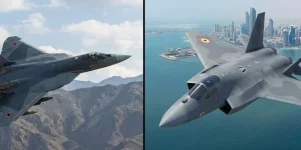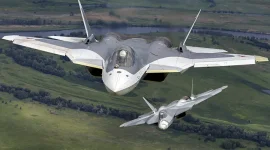- Views: 3K
- Replies: 15
Russia has reportedly presented its Sukhoi Su-35 fighter jet as a candidate for India's Multi-Role Fighter Aircraft (MRFA) tender, a massive acquisition project aimed at procuring 114 new combat aircraft for the Indian Air Force (IAF).
While Russia has increased its domestic production of the Su-35 to support its military operations, the aircraft may not align with the Indian Air Force's long-term strategic and technological requirements, making its selection unlikely despite its formidable reputation.
The MRFA tender, valued at over $15 billion, is a critical initiative to arrest the IAF's declining squadron strength, which currently stands at around 31 against a sanctioned strength of 42. This procurement is intended to replace aging fleets of Jaguar and Mirage 2000 aircraft.
The Su-35, a highly manoeuvrable 4++ generation air superiority fighter, is being offered alongside other global contenders like the F/A-18 Super Hornet, F-15EX, Rafale, and Gripen.
A significant technological deficit of the Su-35 is its lack of an Active Electronically Scanned Array (AESA) radar, which is now a global standard for modern fighter jets.
The Su-35 is equipped with a Passive Electronically Scanned Array (PESA) radar. While capable, a PESA radar is generally less effective than an AESA system, which can simultaneously track a higher number of targets with greater accuracy and is more resistant to electronic jamming.
The absence of this critical technology places the Su-35 at a disadvantage compared to its competitors in the MRFA tender, all of which offer advanced AESA radars.
Furthermore, the aircraft does not feature the advanced avionics, sensor fusion, or stealth-enhancing characteristics being developed for Russia's fifth-generation Su-57 program.
For the IAF, which is looking towards future air combat scenarios, acquiring an aircraft without near-fifth-generation electronics would be a step sideways rather than forward, especially as it develops its own indigenous fifth-generation Advanced Medium Combat Aircraft (AMCA).
Instead of acquiring the Su-35, a more strategically viable option for India appears to be the comprehensive upgrade of its existing fleet of Su-30MKI jets.
The IAF is proceeding with the "Super 30" program, which will see at least 84 Su-30MKI aircraft—the backbone of India's fighter fleet—outfitted with state-of-the-art systems. This approach leverages a proven platform familiar to the IAF while elevating its capabilities to modern standards.
The centerpiece of the Super 30 upgrade is the integration of an indigenous Gallium Nitride (GaN)-based AESA radar, making it technologically superior to the Su-35’s PESA system.
The upgraded jets will also receive next-generation avionics, a modern glass cockpit with a Wide Area Display (WAD), and advanced electronic warfare suites.
Many of these systems are being developed for India’s own Tejas Mk2 and AMCA programs, ensuring synergy, interoperability, and a boost to the national defence industrial base under the 'Atmanirbhar Bharat' (Self-reliant India) initiative.
In conclusion, while the Russian Su-35 is a powerful aircraft, it represents a technological generation that India is moving beyond. The IAF's focus has clearly shifted towards upgrading its reliable Su-30MKI fleet with cutting-edge indigenous technology and pursuing its own advanced fighter programs.
Therefore, the Su-35's limitations in critical areas like radar and avionics make it an improbable solution for India's future air defence needs.


